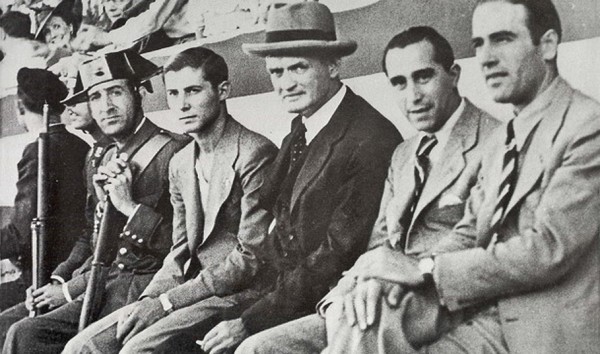
In the 1950s, my mother often spoke of Mrs Streake and her long-lost son Sean. In the late 1930s, Sean left for Spain to fight Franco’s fascists in that ugly civil war.
Mrs Streake had shops in Richmond Street, Kelly’s Corner and Old Camden Street. She always said he would come home soon but, alas, Sean was one of many young Irishmen lost in battle.
This was the world Patrick O’Connell also lived in. Patrick O’Connell was born in 1887 in Dublin and made a living playing football. Around 1910, he played for Belfast Celtic. He was soon sold to Sheffield Wednesday and later moved on to Hull City. Patrick soon moved to Manchester United, where he became captain. He also captained Ireland between 1912 and 1920, when Ireland won the so-called “Home Championship”.
O’Connell wanted to come home but the Irish civil war was in full swing at this time, so he decided to go to Spain, where he stayed for 20 years. On arrival in Spain he became manager of Racing Santander. From 1931 until 1935 he was manager of Real Betis, where he won La Liga. This is the only La Liga title Betis ever won. Outside the Real Betis stadium there is a magnificent water feature and statue to Don Patricio O’Connell, as he was known. To this very day, O’Connell is a God to Real Betis fans.
He later moved to FC Barcelona, where he saved the club from extinction. Around this time the Spanish people elected a left-wing republican government. This did not sit easy with the fascist army, under General Francisco Franco, and the Catholic Church, who received huge military aid from Adolf Hitler and Benito Mussolini.
So began the dystopian ugly civil war, with dreadful casualties on both sides, so vividly depicted in George Orwell’s Homage to Catalonia. Barcelona was the proud capital of Catalonia and got special treatment from Franco’s fascist thugs, including the murder of Señor Sunyol, President of FC Barcelona.
Patrick O’Connell was tipped off that Franco intended to kill the entire Barcelona team and quickly got them on a ship to North America. They played two games in Mexico and four games in the US, where they collected $15,000, a very handsome sum in 1938. O’Connell banked this money in Paris for the future use of FC Barcelona.
When the civil war ended, Don Patricio O’Connell returned to Spain to manage Seville and took them to second place in La Liga. Circa 1950 O’Connell left Spain for good and his life went down to the depths of poverty and despair. He was yesterday’s man. In 1959 O’Connell died in his digs in St Pancras, London, a forgotten man, but not in Spain.
In the FC Barcelona museum there are many busts of club icons, including Messi, Cruyff etc. TG4 showed a film last year about O’Connell, in which we saw and heard the President of FC Barcelona say “We owe all this, our team, our Nou Camp stadium, everything to Don Patricio O’Connell” as he pointed to the handsome bust of Patrick O’Connell.
What about Ireland’s tribute to this sporting great? I shall tell you what the FAI and our loquacious sports fans have done in one word, and I shall say this one word in the three languages Patrick spoke: Aon Ní, Nada, Nothing! Shame on all of us.
Wherever you are Patrick, may you rest in peace.
Pictured: Patrick O’Connell (third from right) photographed during his time as FC Barcelona manager.
By Noel Twamley

